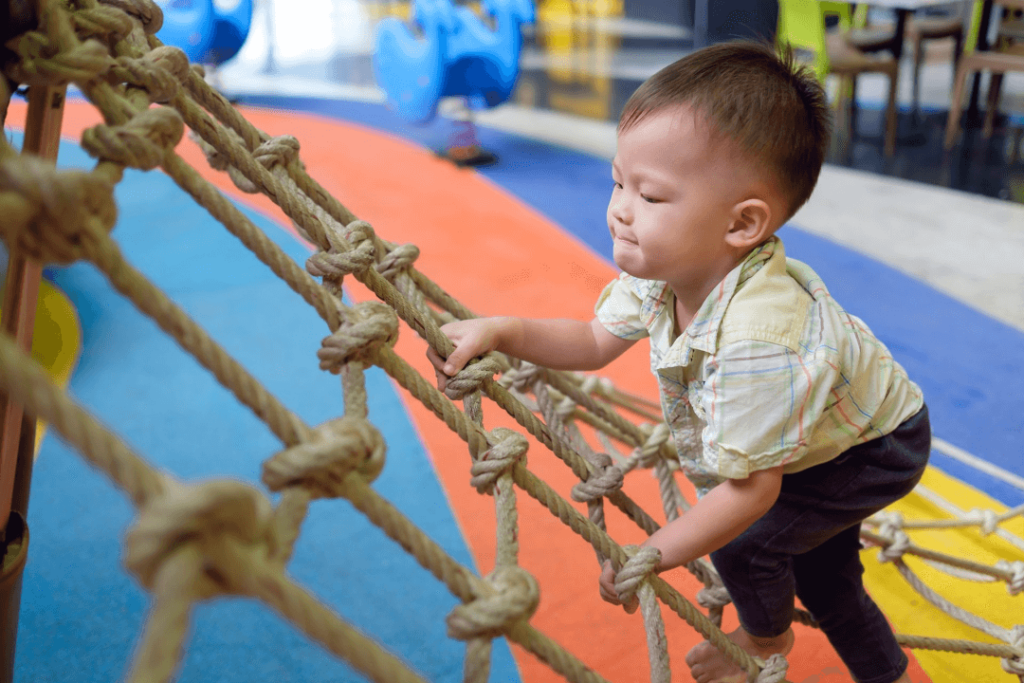As parents, we want to keep our children safe, but we also know that taking risks is a natural part of growing up. When it comes to outdoor play, you may find yourself watching your child climb higher than usual, jump off a swing, or run fast with little regard for the potential consequences. While this can be a bit nerve-wracking, it’s important to understand that this type of play, known as risky play, is essential for a child’s development.
In this blog post, we’ll dive into what risky play is, what it looks like on the playground, the theory behind it, and how it benefits your child’s growth.
What is Risky Play?
Risky play refers to activities that challenge children’s physical, emotional, and cognitive boundaries in a way that can involve a certain level of danger or risk. These activities help children learn to assess risks, make decisions, and develop a sense of confidence and resilience. While risky play involves a level of physical risk, it’s important to note that it’s not reckless play. It’s controlled risk-taking that encourages children to face challenges and learn from them, all while being supervised appropriately.
What Does Risky Play Look Like on the Playground?
Risky play often looks like the following:
- Climbing High or Balancing: Children may climb trees, rock walls, or tall structures. Balancing on uneven surfaces or swinging high on swings are all common examples. These activities require children to gauge their physical abilities and test their limits.
- Jumping or Falling: Jumping off a height, like from a swing or a platform, or running and taking fast turns might make parents uneasy, but it encourages children to develop their strength, coordination, and risk-awareness.
- Exploring Heights, Speed, and Fear: Anything from running at full speed, riding a bike down a steep hill, or engaging in competitive play with others may involve a certain level of risk. These activities encourage physical bravery and the ability to assess what feels safe and what doesn’t.
- Interacting with Nature: Risky play can include playing in natural environments like forests, streams, or areas with loose soil, rocks, or tree branches. These types of play encourage children to interact with and explore the world around them.
- Pretend Play with a Sense of Danger: While not always physical, pretend play where children engage in imaginative scenarios that involve risky actions, such as pretending to cross a river by jumping from stone to stone or playing ‘superheroes,’ helps children understand danger in a safe environment.
The Theory Behind Risky Play
Risky play is grounded in developmental psychology and experiential learning theory. Researchers such as Ellen Sandseter, a Norwegian psychologist, have highlighted how risky play is a vital part of a child’s development, especially in early childhood. According to Sandseter, children’s engagement in risky play helps them develop critical thinking skills, emotional regulation, and resilience. It allows children to explore and test their limits in a safe way while also gaining confidence in their abilities.
The theory behind risky play is also linked to neuroplasticity, which is the brain’s ability to form new connections and adapt to experiences. When children engage in activities that challenge them, their brain forms new pathways that enhance cognitive skills, problem-solving abilities, and emotional intelligence.
How Risky Play Benefits Children
- Builds Confidence and Independence: Risky play encourages children to make their own decisions about what they feel is safe or unsafe. It gives them a sense of control and autonomy, which boosts their self-confidence and independence.
- Develops Physical Strength and Coordination: Climbing, jumping, and balancing all help children develop gross motor skills, strength, and coordination. These activities lay the foundation for more complex physical activities as children grow.
- Teaches Risk Management and Decision-Making: By engaging in risky play, children learn how to assess risks and make decisions. They learn what feels safe and what doesn’t, which helps them make safer choices as they grow older. These skills are also essential for later life when they must make more significant and impactful decisions.
- Promotes Emotional Resilience: Risky play exposes children to small failures (like falling or not succeeding in a challenge), but it also helps them learn how to cope with disappointment, frustration, and the feeling of failure. This emotional resilience is a key skill that children will continue to rely on throughout their lives.
- Fosters Social Skills: Risky play often involves interactions with peers, and it requires children to cooperate, negotiate, and sometimes resolve conflicts. It provides children with opportunities to practice these social skills in a context that is often more authentic and complex than structured play.
- Improves Problem-Solving Skills: Risky play pushes children to think critically and solve problems. For example, when climbing, they must figure out the best way to ascend and descend safely. This type of thinking extends beyond the playground and can benefit academic and life challenges.
Our Role as Parents
While risky play is essential, it’s important for parents to strike a balance between encouraging independence and ensuring safety. This means allowing your child to engage in challenging activities but providing guidance when needed. Supervision is key, but it’s also important to avoid being overly protective.
Encouraging risky play doesn’t mean letting children engage in dangerous activities without boundaries. It means fostering an environment where children can push their limits in a safe way, explore their abilities, and learn about themselves in the process.
In conclusion, risky play is an essential part of childhood development. By providing children with opportunities to explore, take risks, and solve problems, we equip them with the skills they need to navigate life’s challenges. Instead of shielding them from risks entirely, encourage your child to embrace these experiences while guiding them safely. This will help them grow into confident, capable, and resilient individuals. So, the next time you see your little one scaling the jungle gym or testing their limits, remember—it’s all part of their healthy development.

اللعب المليء بالمخاطر: مساعدة الأطفال على النمو من خلال التحدي والمرح
كآباء، نريد الحفاظ على سلامة أطفالنا، ولكننا نعلم أيضًا أن المخاطرة هي جزء طبيعي من مرحلة النمو. عندما يتعلق الأمر باللعب في الهواء الطلق، قد تجد نفسك تراقب طفلك وهو يتسلق أعلى من المعتاد، أو يقفز من الأرجوحة، أو يركض بسرعة دون اكتراث للعواقب المحتملة. إن توفير التوجيه عند الحاجة والإشراف بشكل مناسب يساعد الأطفال على دفع حدودهم بأمان. على الرغم من أن هذا قد يكون مقلقًا بعض الشيء، من المهم أن نفهم أن هذا النوع من اللعب، المعروف باللعب المليء بالمخاطر، ضروري لتطور الطفل.
في هذه المقالة، سنتناول ما هو اللعب المليء بالمخاطر، وكيف يبدو على الملعب، والنظرية وراءه، وكيف يفيد نمو طفلك.
ما هو اللعب المليء بالمخاطر؟
اللعب المليء بالمخاطر يشير إلى الأنشطة التي تدفع حدود الأطفال الجسدية والعاطفية والمعرفية بطريقة محكومة، وغالبًا ما تتضمن درجة من الخطر. تساعد هذه الأنشطة الأطفال على تطوير مهارات حاسمة مثل اتخاذ القرارات، وبناء الثقة بالنفس، والمرونة. من المهم أن نلاحظ أن هذا ليس لعبًا متهورًا؛ إنه يتعلق بتشجيع المخاطرة المحكومة مع الإشراف المناسب.
كيف يبدو اللعب المليء بالمخاطر على الملعب؟
يشمل اللعب المليء بالمخاطر الأنشطة التالية:
- التسلق والتوازن: تسلق الأشجار أو الجدران الصخرية والتوازن على الأسطح غير المستوية يساعد الأطفال على اختبار حدودهم وتقييم قدراتهم الجسدية.
- القفز أو السقوط: القفز من ارتفاعات أو اتخاذ منحنيات سريعة يعزز التنسيق والقوة.
- استكشاف الارتفاعات، السرعة، والخوف: الأنشطة مثل ركوب الدراجات على منحدر أو اللعب في ألعاب سريعة تساعد الأطفال على فهم حدودهم الجسدية.
- التفاعل مع الطبيعة: اللعب في بيئات تحتوي على تربة رخوة أو صخور يساعد الأطفال على التفاعل مع العالم الطبيعي.
- اللعب التخيلي: قد يشارك الأطفال في سيناريوهات مثل التظاهر بعبور نهر، مما يساعدهم على فهم الخطر بطريقة آمنة.
النظرية وراء اللعب المليء بالمخاطر
اللعب المليء بالمخاطر مستند إلى علم النفس التنموي، حيث يعزز التنظيم العاطفي والمرونة والتفكير النقدي. يشير الباحثون مثل إلين ساندتير إلى كيف يساهم اللعب المليء بالمخاطر في تطوير التفكير المعرفي والثقة بالنفس. كما أنه يدعم المرونة العصبية، التي تسمح للدماغ بإنشاء مسارات جديدة من خلال التجارب التحديّة، مما يعزز مهارات حل المشكلات.
كيف يفيد اللعب المليء بالمخاطر الأطفال
- يبني الثقة بالنفس والاستقلالية: يتخذ الأطفال قرارات بشأن ما يشعرون أنه آمن أو غير آمن، مما يعزز ثقتهم واستقلالهم.
- يطور القوة الجسدية والتنسيق: الأنشطة مثل التسلق والقفز تحسن المهارات الحركية والقوة الجسدية.
- يعلم إدارة المخاطر: يعزز اللعب المليء بالمخاطر مهارات تقييم وإدارة المخاطر لدى الأطفال، مما يفيدهم في مراحل حياتهم القادمة.
- يعزز المرونة العاطفية: يتعلم الأطفال كيفية التعامل مع الفشل الصغير والانتكاسات، مما يعزز مرونتهم.
- يعزز المهارات الاجتماعية: غالبًا ما يتضمن اللعب المليء بالمخاطر التفاعلات مع الأقران، مما يساعد الأطفال على تطوير مهارات التعاون وحل النزاعات.
- يحسن مهارات حل المشكلات: يتطلب اللعب المليء بالمخاطر من الأطفال التفكير النقدي وحل المشكلات، وهي مهارات تفيدهم في التحديات الأكاديمية والحياتية.
الخاتمة
اللعب المليء بالمخاطر هو جزء حيوي من تطور الطفولة، فهو يعلم الأطفال المرونة والثقة بالنفس ومهارات حل المشكلات. من خلال السماح للأطفال بالمشاركة في هذه التجارب بأمان، نحن نعدهم لتحديات الحياة، مما يساعدهم على النمو ليصبحوا أفرادًا قادرين ومرنين. لذلك، دع طفلك يتسلق ألعاب الأطفال – إنها جزء من تطوره الصحي!


